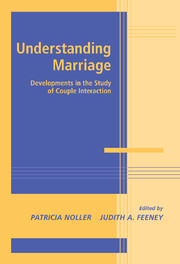Book contents
- Frontmatter
- Contents
- Contribitors
- Introduction
- SECTION ONE THE EFFECT OF COGNITION ON INTERACTION PATTERNS
- Introduction to Section One
- 1 Thought and Action: Connecting Attributions to Behaviors in Married Couples' Interactions
- 2 Self-Evaluation Motives in Close Relationships: A Model of Global Enhancement and Specific Verification
- 3 Competition in Romantic Relationships: Do Partners Build Niches?
- 4 Cognition and Communication during Marital Conflict: How Alcohol Affects Subjective Coding of Interaction in Aggressive and Nonaggressive Couples
- SECTION TWO UNDERSTANDING THE IMPORTANCE OF POSITIVE INTERACTION
- SECTION THREE COPING WITH DISAPPOINTMENT, CRITICISM, AND BETRAYAL
- SECTION FOUR POWER, CONFLICT, AND VIOLENCE IN MARITAL INTERACTION
- Marital interaction at important transition periods
- SECTION SIX Interventions for strengthening relationships
- Conclusions
- Index
- References
4 - Cognition and Communication during Marital Conflict: How Alcohol Affects Subjective Coding of Interaction in Aggressive and Nonaggressive Couples
Published online by Cambridge University Press: 25 July 2009
- Frontmatter
- Contents
- Contribitors
- Introduction
- SECTION ONE THE EFFECT OF COGNITION ON INTERACTION PATTERNS
- Introduction to Section One
- 1 Thought and Action: Connecting Attributions to Behaviors in Married Couples' Interactions
- 2 Self-Evaluation Motives in Close Relationships: A Model of Global Enhancement and Specific Verification
- 3 Competition in Romantic Relationships: Do Partners Build Niches?
- 4 Cognition and Communication during Marital Conflict: How Alcohol Affects Subjective Coding of Interaction in Aggressive and Nonaggressive Couples
- SECTION TWO UNDERSTANDING THE IMPORTANCE OF POSITIVE INTERACTION
- SECTION THREE COPING WITH DISAPPOINTMENT, CRITICISM, AND BETRAYAL
- SECTION FOUR POWER, CONFLICT, AND VIOLENCE IN MARITAL INTERACTION
- Marital interaction at important transition periods
- SECTION SIX Interventions for strengthening relationships
- Conclusions
- Index
- References
Summary
At the base of every marital conflict there is a rupture of consensus. All conflicts involve differences in perception that increase in depth and magnitude as a dispute escalates. While couples may resolve or put aside differences by talking together, communication can also inflame matters and drive perspectives further apart. The variable effects of communication partly stem from the way communication itself is subjectively construed. In a bitter quarrel, disagreements are not confined to the surface issues and background events associated with conflict. Individuals may also perceive the stream of interaction differently (Watzlawick, Beavin, & Jackson, 1967), and this fact accounts for the explosive nature of some conflicts. To follow this reasoning a step further, communication patterns are also implicated in marital conflicts that culminate in violence (for example, Lloyd & Emery, 2000a). Further, there are strong indications that distorted perceptions of interaction, particularly by maritally violent men, contribute to the dysfunctional communication patterns of aggressive couples (Eckhardt, Barbour, & Davison, 1998). Thus, to better understand the role of communication in marital conflict and aggression, it is useful to consider not only how couples talk with each other, but also the subjective interpretations that accompany these acts.
In this chapter we look at the interpretive process connected with marital interaction, drawing upon a study of couple conflict, aggression, and alcohol. In this research the conscious thoughts and feelings that individuals experienced during couple interactions were reconstructed using video-assisted recall methods.
Information
- Type
- Chapter
- Information
- Understanding MarriageDevelopments in the Study of Couple Interaction, pp. 85 - 112Publisher: Cambridge University PressPrint publication year: 2002
References
Accessibility standard: Unknown
Why this information is here
This section outlines the accessibility features of this content - including support for screen readers, full keyboard navigation and high-contrast display options. This may not be relevant for you.Accessibility Information
- 12
- Cited by
